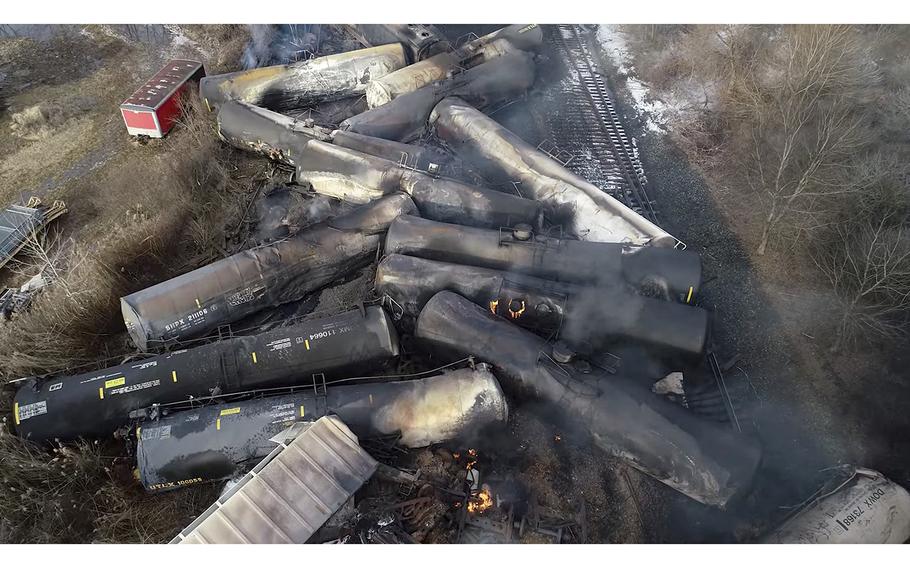
A video screen grab shows the freight train in East Palestine, Ohio, on Feb. 6, 2023, three days after the derailment. (National Transportation Safety Board)
On Feb. 3, 2023, a train carrying toxic chemicals crashed in northeastern Ohio, sending up a large black cloud over Ohio and Pennsylvania after officials decided to burn off the hazardous materials. As the chemicals lofted into the air, the pollution spread as far as 16 states, according to a new study.
“I didn’t expect to see an impact this far out,” said David Gay, lead author of the study. “There’s more going on here than most people would have guessed, including me.”
Toxic chemicals rained down from South Carolina to Wisconsin to New England following the accident, according to the new analysis in the Environmental Research Letters journal. Overall, the pollution spread over 540,000 square miles, or 14 percent of U.S. land area.
People closer to the accident reported rashes, nausea and headaches — but Gay said the low chemical concentrations farther away from the accident weren’t “toxic, but are pretty unusual at a lot of places.” Many of those pollutants can run off and affect marine and plant life.
“It’s not death and destruction. It’s fairly low concentrations, but they are very high relative to the normal that we typically see — some of the highest we’ve measured in the last 10 years,” Gay said.
The accident occurred around 9 p.m. on Feb. 3 near East Palestine, a town of almost 5,000 residents on the Ohio-Pennsylvania border. The train, operated by Norfolk Southern, experienced a mechanical issue that caused more than 50 cars to derail. Some of the trains were carrying hazardous materials, including a known human carcinogen called vinyl chloride.
In an emergency decision, officials authorized a controlled burn of the hazardous chemicals to prevent a catastrophic explosion. But as the vinyl chloride burned, it broke into separate chloride and hydrogen ions in the atmosphere that got carried by the wind to other locations.
When it began to rain in various places, the pollutants were pushed from the air and deposited on the ground. The National Atmospheric Deposition Program, at the University of Wisconsin at Madison, collects these ground depositions weekly across 260 sites across North America. Gay, who serves as coordinator of the program, routinely analyzes the data to monitor air pollutants.
“If you have a lot of pollution in the atmosphere, you get a lot of wet deposition pollution at the ground,” Gay said.
He and his team analyzed ground depositions from the week of and following the train accident (Jan. 31 to Feb. 14), and then compared them to the previous decade or so. Many samples taken during the week of the accident in Pennsylvania, Michigan, Massachusetts, Wisconsin and New York were flagged for contamination, showing soot, ash and dirt.
Initially, Gay expected to see only a few abnormally high chloride signals nearby in Pennsylvania, but the impact was much higher than he anticipated. High chloride concentrations spanned as far as Virginia, South Carolina and Wisconsin. The highest concentrations were located near the Canada-New York border, which was downwind of East Palestine.
The pollutants disappeared within two to three weeks after the accident.
The data also showed another unusual trend for the researchers. Gay explained that typically rain without pollutants is a bit acidic, meaning it has a good amount of hydrogen ions. However, the collected samples showed less hydrogen ions than usual, making the rain more basic than expected. Gay suggests that metals emitted from the fire, like calcium, sodium, potassium and magnesium, helped to suck up a bunch of those hydrogen ions that are normally present in our atmosphere.
“This study is unique and elegant as it clearly documents the impact that these kinds of accidents can have,” said Juliane Beier, a leading expert on the effects of vinyl chloride who was not involved in the study.
But she said this is not the first time researchers have seen distal effects of local environment events, and it’s unclear what long-term impact such environmental exposures could have on communities.
“I think we should be concerned,” Beier said.